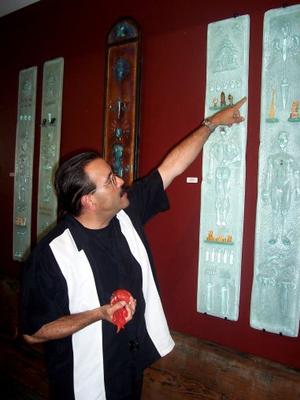I’ve been a member of the WPA since I first moved to the DMV decades ago, and have participated in many shows and opportunities offered by the WPA, including several Gala auctions, the (e)merge art fairs, etc. I was also one of the “Sweet 16” selected by ubercollector Mera Rubell during her storied 2009 studio visit tour.
As many of you have already read, I have been retained by the WPA/C to curate a show for them. I will be assisted by two young WPA/C interns: Sandra Fernandez and Adrian Schneck.
Because this show will be exhibited at the three separate buildings that comprise the Warehouse Theatre and Galleries complex, a total of seven separate spaces are available, and all will be used, and thus the exhibition title: Seven.
Using the power of the web, I intend to keep this curatorial process open and available to everyone via commentary here on what I am doing, how and why. In doing so, I hope to bring to light all the many issues, baggage, ideas, agendas, nepotism, and a complete lack of objectivity that a curator brings to such a massive job as this will be. As well as a lot of hard work and a good work ethic to deliver a show that will make all involved proud to be part of it. All artwork and artists to be displayed will be picked by me.
I will also try to handcuff some of my fellow commercial gallerists and, once the exhibition is open, take them around and have them discover (hopefully) some new talent from our area. It is my hope that the final selection of artists will be a good blend of some well-known area WPA/C artists as well as an exhibition opportunity for WPA/C talent that we don't see as often.
To start, I have decided to focus each of the seven spaces on a specific theme, genre or subject... sort of. I will also bring to this selection process (and to one space) the commercial acumen of a for-profit gallerist. As such (for example), I will select the artwork that will go in the main gallery space (co-located with the Warehouse Cafe) to be that work that I feel represents the best compilation of all the remaining spaces and also stands the best chance (in my sole opinion) of being sold.
Other spaces will have different approaches; for example, on my first run through all of the WPA/C slides, I was pleasantly surprised at the high quality of a lot of abstract paintings, and will thus hope to deliver a gallery full of those artists that (in my opinion) are the best from the membership.
Another space will be focused on a particular agenda item of mine: the nude figure. And thus I hope to deliver a gallery full of figurative nudes. At this time, I am also toying with the idea (space and logistics permitting) of having a figure drawing class, nude model and all, present at the opening. This is in the hope that they (the artists and the model) will provide an in situ perspective on the trials, tribulations and joy of creating artwork from the live model.
Details on the exhibition and entry process is available online here. All members of the WPA/C are eligible for consideration, but all final decisions and selections are mine.
I've already gone through all the WPA/C slides once (about 20,000 of them I'd guess), and will review all new entries and slides that come in between now and some future date a couple of weeks before the exhibition opens on June 30, 2005. I also intend to re-review all slides in the registry next week.
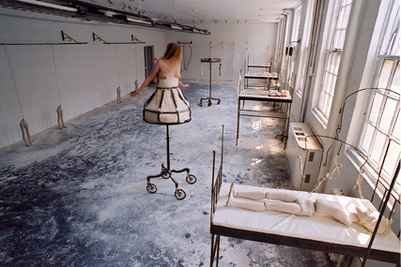
And I've already made some surprising discoveries and even some selections! In fact the first artist selected, and one whose work I did not know, is a MICA graduate and VCU MFA candidate Alessandra Torres. The image above is hers, and that's the artist as part of a sculptural installation titled Possess/(pose-us).
More later... keep checking; I truly intend for this exhibition to be provocative and fresh, but in the end it still remains one person's opinion and the trite saying that art is in the eye's of the beholder never applied more aptly than in this case: My eyes and thus my Seven.
Seven Update One
I'll be walking through the Warehouse spaces sometime today, along with some artists whose work I'd like to include in the coming "Seven" exhibition.
Visit here to enter "Seven."
Seven Update Three
I've re-visited about a third of the 24,000-plus slides in the WPA/C Artfile. There are a lot of old slides in there (including mine), and also a lot of WPA/C members don't have slides on file. Tsk, tsk...
I've also received quite a few entries electronically via email, and in some cases from members updating their files.
The selection process continues, and so far I've selected about thirty or so artists, most of which have or will receive an email from the WPA/C. I think that I will probably end up picking up about twenty or so more. After all the seven spaces at the Warehouse are quite ample, and I also have this salon-style vision for at least one of the spaces.
I've also invited (and they've accepted) Sam Gilliam and Manon Cleary, without a doubt two of DC's best known and most respected artists.
A few other artists that I wanted in this show have been unable to participate due to the fact that two of them have moved away and one is working furiously for a coming show and already has a waiting list for his next paintings!
There are also quite a few artists whose work I did not know... and this is part of the two way dialogue that happens between a curator and 24,000 slides.
There are dozens and dozens of very good artists who will not an invitation, but that have made a positive impression on me, and thus in a way are also gaining from this experience, as there's a good chance that their work may appear in something else associated with me in the future.
And that is why it is important to get out there and have slides in registries, and work online and so on: it needs to be seen!
Even being rejected has a possible positive footprint.
Case in point: Rebecca D'Angelo. Nearly ten years ago, Rebecca approached me with an exhibition proposal for a specific series of her photographs. The idea was interesting, but (for a then struggling commercial gallery) not very feasible, and so I told her no.
Years later, as I walked the seven various spaces that comprise the Warehouse holdings on 7th Street, one of them jumped in my mind as being perfect for Rebecca D'Angelo's project. I contacted her, she visited the spaces, and agreed!
Wait till you see it (her project that is). Opening night for "Seven" is June 30th from 6-8:30PM. Set that night aside.
Seven Update
Today, together with a few artists, one of the interns, and Kim Ward from the WPA/C and a photographer from the Washington Times, I walked the seven spaces at the Warehouse Gallery again.
We assigned some spaces already, and selected a few more artists. The WPA/C website will soon have the final list, which now includes Chan Chao, Adam Fowler, David Jung, Marie Ringwald, Rick Wall and many others.
I've also turned Mark Jenkins loose on the building, and I am sure that he will have an interesting tape people army present at the opening and for the duration of the show.
Now closing the loop on a drawing class that I want to have present at the opening. I have focused one of the seven galleries on the nude figure, and on opening night (June 30), I want to have a small drawing class present and drawing from a live nude model or two.
Seven (Done)
From the several thousand eligible artists (WPA/C members), I've chosen
Sometime next week I will take several of my fellow DC gallerists for a private view and tour of the show, hoping that they will discover some new talent (new to them) in the exhibition.
I also have several museum and a handful of independent curators (two from as far as Los Angeles and two from New York and one from the Midwest) in the process of being lined up to visit the show in the next few weeks. More on that when it happens.
And I will also take some well-known DC art collectors on a group tour sometime in the next couple of weeks; this is (after all) a fundraiser for the WPA/C.
The opening reception is Thursday, June 30th from 6 - 8:30PM.
The Seven Chosen
Artists selected for SEVEN are listed below; about a third of them are completely new to me. The rest I either knew their work, or who they were in some way or form. I think it is a powerful lesson on the importance of keeping your work "out there," no matter where "there" is, so that the work is "seen."
There are some well-known, experienced and recognized names on this list, people like Manon Cleary, Chan Chao and Sam Gilliam, as well as hot, young new artists like Lisa Bertnick, John Lehr and Kelly Towles.
Also young emerging artists like Alessandra Torres, Ben Tolman and Susan Jamison (who's in the current issue of New American Painting and also hangs in the Strictly Painting V exhibition at McLean). And also artists whose work I've rarely seen anywhere around our area, such as Gary Medovich, Rebecca D’Angelo, Sonia Jones, Lou Gagnon and Fae Gertsch.
This exhibition, having been curated by a gallerist, defines a show from the perspective of a curatorial eye aimed at perspective of intelligent, strong and visually powerful art and art ideas; this is my view from the ground-level; not the 10,000 foot level of a museum office.
As such, it is very painting-centric show at at time when painting (in spite of the constant attack from academia and the written word) seems to have regained center stage in the international art arena.
It is not a competition between the genres, and because of the agenda, prejudices and humanity of my selection process, in the end, Seven somewhat places painting at the center of attention, although I suspect that a strong showing by WPA/C photographers and what I expect to be a very memorable performance by Kathryn Cornelius, and an arresting installation by Alessandra Torres, will definately gather a big share of the public and media attention as well.
Here's the list:
Virginia Arrisueño
James W. Bailey
Joseph Barbaccia
Lisa Bertnick
Margaret Boozer
Mark Cameron Boyd
Adam Bradley
Scott Brooks
Lisa Brotman
Jonathan Bucci
Diane Bugash
Graham Caldwell
Chan Chao
Manon Cleary
Kathryn Cornelius
Rebecca Cross
Richard Dana
Rebecca D’Angelo
Margaret Dowell
Mary Early
Chris Edmunds
Victor Ekpuk
Michael Fitts
Adam Fowler
Lou Gagnon
Fae Gertsch
Sam Gilliam
Matthew Girard
Pat Goslee
Kristin Helgadottir
Linda Hesh
Maremi Hooff
Michal Hunter
Scott Hutchison
Melissa Ichiuji
Susan Jamison
Michael Janis
Mark Jenkins
Sonia Jones
David Jung
J.T. Kirkland
Sonya Lawyer
Tracy Lee
John Lehr
Joey Manlapaz
Matthew Mann
Amy Marx
Jeanette May
Maxwell McKenzie
Gary Medovich
Adrianne Mills
Allison Miner
Peter Photikoe
Sara Pomerance
Marie Ringwald
Molly Springfield
Tim Tate
Erwin Timmers
Ben Tolman
Alessandra Torres
Kelly Towles
Rick Wall
Frank Warren
Sarah Wegner
Andrew Wodzianski
Denise Wolff
Samantha Wolov

Mark Jenkins installation for Seven, titled "Tres Marias," has already been installed in the trees outside the Warehouse Theatre and Galleries; inside Kelly Towles is already laboring on a wall, and Alessandra Torres will soon start on transforming a room.
Seven's opening is this Thursday starting at 6PM.
Seven: Installation Day One
As with any large, multi-gallery exhibition, there were some hiccups on the first day of Seven's installation, which forced the move of a very visible spot to another area (thank God for a very flexible artist); plus the mysterious move of some artwork from one area to another; and the selected artist whom we all forgot to add to the master list; and the usual last minute broken glass...
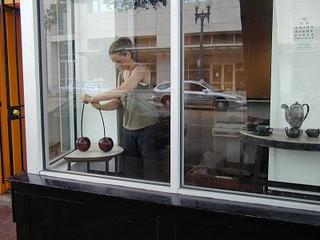
And Mark Jenkins' tape sculptures have somehow moved from the tree in front of the buildings to the building itself!
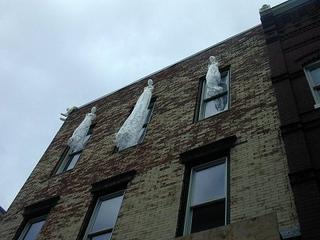
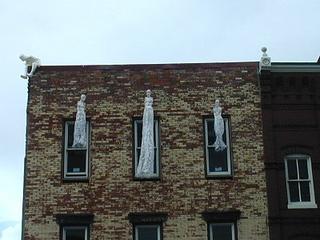
And below is Kelly Towles painting a wall in the second floor gallery...
I am so tired! Early wake-ups all this week; plus late nights at Warehouse for the hanging of Seven.
A couple of small disasters today: One of Rebecca Cross' delicate ceramic pieces fell off the wall and broke; time to scramble and see if Rebecca can replace it with another work.
Then a major piece by a very good artist could not be hung due to weight and size, and now we are left scrambling trying to figure out what to do; things will resolve themselves by tomorrow.
And then there's the artist who wanted his work "hung just so," and so we reserved a very special place for this person, and so far the artist has not delivered any work or returned several messages. Where are you?
And (as anyone who has ever curated a show from slides knows), there's the "surprise."
The "surprise" is that piece of artwork that looks great in a slide, but that once you see it, it... well, uh... disappoints.
Oh well.... one surprise from 67 artists is not bad.
On the pleasant side, Alessandra Torres continues to astound me on the good side; seldom have a seen a young artist be so full of energy and zeal and talent. I predict good things for her.
And Kathryn Cornelius damned near made me a convert to video art; wait until you see her video piece (Titled "Resolve" and being projected on opening night at the top floor - all by herself - and later on a flatscreen in the second floor gallery).
And I predict that Scott Brooks and Samantha Wolov are going to raise some eyebrows (and maybe other body parts on Wolov's case).
The opening is tomorrow, Thursday June 30 at 6PM.
See ya there!
Seven Opens Tonight
What: Seven, an exhibition of 67 WPA/C artists curated by me.
When: Opens tonight with a catered reception for the artists starting at 6PM. Work on exhibition until Sept. 9, 2005.
Where: The seven spaces that make up the Warehouse Theatre and Galleries complex. Located at 1021 7th Street, NW, across from the new Washington Convention Center.
See ya there!
Breedloves... and Seven opening photos

Those of you who attended the huge opening of Seven last Thursday at the Warehouse, know that one of the highlights of the opening was the magnificent voice of Hisham Breedlove, who delighted the crowd with not only his painted body, but also with his magnificent voice.
Hisham walked around the seven galleries that make up the show, singing a variety of opera solos; and he was spectacular!
Adrienne Mills recorded the Breedlove's transformation in this series of photographs from the opening of Seven. See them here.
More photos from the opening below (all courtesy Adrienne Mills):
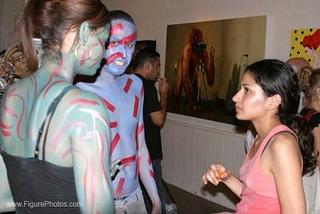

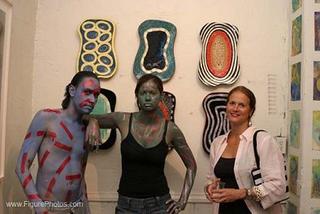
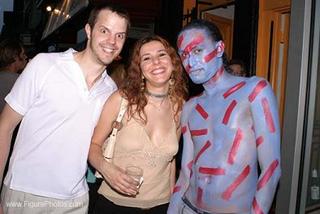
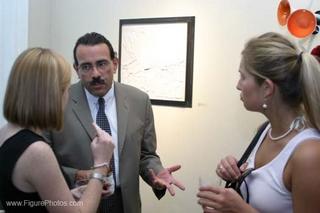
 CNN News will videotape coverage of Seven sometime next week.
CNN News will videotape coverage of Seven sometime next week.Since it is (apparently) of national interest... perhaps the local papers can consider it of local interest as well?
These collector walk-throughs will continue throughout the exhibition; after all, Seven is supposed to be a fundraiser for the WPA/C.
CNN videotaped a segment with Kim Ward, the Acting Executive Director of the WPA/C. The interview covered the history and mission of the WPA/C, a bit about Warehouse, a few shots of the show, and a plug for the Artist's Directory. I do not have the schedule for the air times; hopefully next week. It will be on for the last five minutes at the top of the hour on CNN Headline News in certain markets. I do know that they will show the spot 8 times a day for one week before the show closes.
Jessica Dawson has a mini review of Seven in today's Washington Post's Galleries column. Read it here.
Read the review here.
Just back from the curator's talk at Seven. A nicely sized crowd showed up, which was a little surprising to me, since usually it has been my experience that these curator talks only attract the artists involved. Thanks to all the DC Art News readers who came by and said howdy.Bailey has a nice photo storyline of the talk here.He also managed to fall in love in the subway on the way to Seven and on the way back! The two photos below are courtesy of Bailey:

Me outside Warehouse discussing Seven
Me discussing Tim Tate's work
And the below photo courtesy of Mark Cameron Boyd:

After the talk Alessandra and her family took me out to dinner to Lauriol, where I had some excellent Cuban food.
And Bailey also managed to whip out a monster letter to the Washington Post editors taking Jessica Dawson on for her dismissal of Seven.
It's OK; it's her right as a critic.
And yet, a bad review is better than no review at all. Jessica's expected dismissal of the show has nonetheless resulted in one major sale to an important DC collector.
In addition to Jessica's and John Blee's review, there are three separate other reviews being written right now, and hopefully they will be published soon; let's see what some other observers think.
The visual arts carry a monkey on their back that none of the other genres of the fine arts have to deal with: the proprietarization of subject matter.
So, no contemporary artist would dare to, let's say, paint ballerinas (sorry but Degas closed that subject), or harlequins, etc.
And some subject matter, by the nature of the subject itself, would be labeled as saccharine by the nicest of critics. Say kittens, horses, puppies, mermaids.
Do we have a screwed up sense of what makes the visual arts tick or what?
 This powerful painting, titled "Allegory of a Gay Bashing" by Scott Brooks has been receiving a lot of attention in the "nude gallery" in Seven. It is an homage by Brooks to the brutal murder of Matthew Sheppard.
This powerful painting, titled "Allegory of a Gay Bashing" by Scott Brooks has been receiving a lot of attention in the "nude gallery" in Seven. It is an homage by Brooks to the brutal murder of Matthew Sheppard.And this painting swings representational painting's most formidable weapon (and the one that keeps painting as king of the hill in spite of all the critics and curators trying to kill it): The ability to convey an entire and diverse range of emotions with just one glance."Allegory of a Gay Bashing" delivers horror, beauty, politics, history and homage all in one swoop.
And this tremendous work will probably never be sold to anyone by Brooks, because it would take immense courage to display this work of art anywhere in this nation; not just DC, but anywhere. Someone can prove me wrong and buy it from Brooks and display it in their home, or office or even a museum somewhere - but I doubt that there's a collector or museum in the USA with the cojones to hang this work.
 And to get to the beginning point of this ramble, in spite of the horror delivered by "Allegory of a Gay Bashing", many people get stuck on one area: the cute puppy and kitty at the bottom of the castrated nude.
And to get to the beginning point of this ramble, in spite of the horror delivered by "Allegory of a Gay Bashing", many people get stuck on one area: the cute puppy and kitty at the bottom of the castrated nude.I've been in the room when I hear people discussing it. It seems like the cute puppy and kitty sitting on the ground, and staring at the viewer, evoke a higher sense of revulsion than the castrated man himself.
I've noted people's sense of repulsion caused by juxtaposing the two disparate sets of images. I think that they are repulsed by the cute animals being forced to share a scenario with a tortured man. Why are they there? people ask each other, a note of discomfort in their voices. Even the eloquent Amy Watson was disoriented by the presence of the animals and (in her terrific review of the show) felt that they undermined the painting.
 Cute kitty and cute puppy... taking the attention away from disturbing image. How dare Brooks paint cuteness, especially in this context?
Cute kitty and cute puppy... taking the attention away from disturbing image. How dare Brooks paint cuteness, especially in this context?I don't know why Scott did it, but I think that it is the key that makes this painting truly repulsive and immensely successful all at once. Take them out, and you have a strong, powerful painting. Put them in, and you create a million questions, enormous angst and a desire to physically remove the creatures from the canvas itself.
And maybe without even realizing it, Scott has also reclaimed an artist's right to paint or draw anything that he or she so desires, and take the unjustified saccharinity of a subject and turn saccharine into anthrax with a few deft strokes of a painter's brush and a disorienting sense of juxtapositioning of subject matter.
Update: Sam Wolov has some thoughts on this subject.
Bailey interviews two of Seven's more controversial artists:Samantha Wolov here
and Scott G. Brooks here.
Seven in Art Film
Seven will be filmed this week as part of a documentary on contemporary art being produced by Deno Seder Productions.
Their art films and videos have won top honors at the Paris Art Film Biennial at the Georges Pompidou Center, the Berlin Film Festival, the Taipei International Film Festival, the Chicago and Houston International Film Festivals, the New York Underground Film Festival and others. One of their films, "Andy Warhol," was screened at the Corcoran during their Warhol exhibition.
Yesterday an international crew filmed the Seven exhibition at the Warehouse.
They seemed to prefer (and focused upon) Alessandra Torres' installation and photographs, Kathryn Cornelius' video, Tim Tate's glass sculptures, Margaret Boozer's floor "crack" installation and Joe Barbaccia's sculptures.
In the next few days they will be also filming Mark Jenkins' street sculptures around DC, which they also liked a lot.
It was interesting to me to get a sort of outsider "validation" about the quality of the show and the artists, from an experienced crew and director who have done a lot of traveling, filming, interviewing and art hopping around the world, and still have loads of praise for the artwork being created by our area artists.
Cool uh?
Torres Interview
Bailey has a terrific interview with Seven artist Alessandra Torres.
Read it here.
One of the goals that I had hoped to accomplish for Seven (besides making it a success as a fundraiser and expose WPA/C members' work), was to also drag some of my fellow gallerists through the exhibition in the hope that they could find some artists of interest to them.
Thus far, I am told of at least five artists from Seven who have been signed up or offered contracts or exhibitions by area galleries.
Cool uh?
Read it here.
